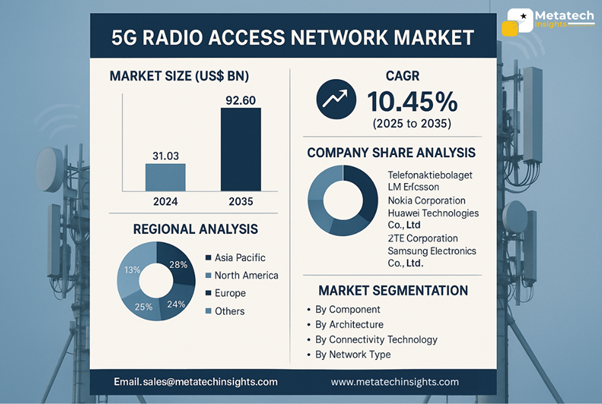Global 5G Radio Access Network Market to Hit USD 92.60 Bn by 2035 | CAGR 10.45%
22 Aug 2025 | Report ID: MI3378 | Industry: Novel Technology | Pages: 220 | Forecast Year: 2025-2035

Read more about this report- Global 5G Radio Access Network Market to Hit USD 92.60 Bn by 2035 | CAGR 10.45%
The 5G Radio Access Network (RAN) Market is valued at USD 31.03 Billion in 2024. The 5G Radio Access Network Market will achieve USD 92.60 Billion by 2035 through a projected 10.45% CAGR from 2025 to 2035.
Increasing data traffic and high demand in ultra-low latency networks to accommodate autonomous systems and industrial IoT on a worldwide basis are the major market growth factors in this market. Nevertheless, the significant installation prices of the 5G infrastructure in rural or underdeveloped areas have been classified as a constraint. One of the opportunities is the growth of Open RAN architecture that enables the interoperability between vendors and speeds up the process of innovation and cost-efficiency.
The 5G RAN market is categorised according to the following parameters: Component (Hardware, Software, Services), Architecture (Centralised RAN, Distributed RAN, Virtualised RAN), Connectivity Technology (Standalone, Non-Standalone), Network Type (Public, Private), Application (Smart Cities, Industrial Automation, AR/VR, Autonomous Vehicles) and End-user (Telecom Operators, Enterprises, Government). Amongst them, virtualised RAN (vRAN) is experiencing high growth with many features of flexibility, low CAPEX/OPEX, and support of multiple vendors and advanced network functions through cloud-native settings.
Such use cases are for industrial automation, smart cities, autonomous transportation, immersive media, and mission-critical services. The 5G RAN technology is driving industrial automation because it supports real-time monitoring, smart maintenance, and factory robots with the support of private 5G networks, and it is powered by AI-enabled edge computing and digital twin technology. State-supported efforts like the South Korean 5G+ strategy that encourages infrastructure deployment on a national level and provides subsidies to industries using 5G technology are also contributing significantly to increased deployment.
The 5G RAN industry is supported by five geographical regions, namely North America, Europe, Asia-Pacific, Latin America, and the Middle East & Africa. The development of localised 5G networks in Japan, the demand for this market by enterprises, and the incentives provided by the government to the 5G spectrum encourage the aggressive network modernisation and industrial digitalisation efforts.
Major players within the 5G RAN industry are Nokia, Ericsson, Huawei, Samsung Networks, and Mavenir. They are influencing market competition by making these strategic combinations, Open RAN, cloud-native RANs deployment, and AI-driven network optimisation, among other efforts that have made the world take a step forward into scalable software-defined mobile networks.
Maximize your value and knowledge with our 5 Reports-in-1 Bundle - over 40% off!
Our analysts are ready to help you immediately.
